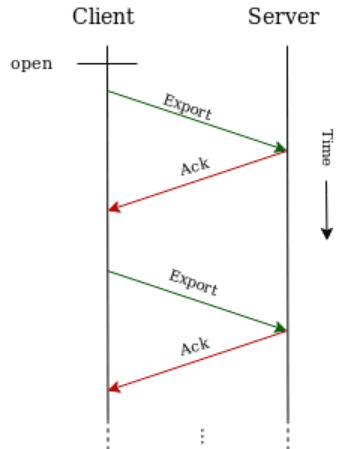
Introduction to OpenTelemetry Protocol (OTLP)
Feeling lost in a sea of fragmented data from your applications? Metrics scattered across different tools, making performance analysis frustrating? You're not alone. Traditional monitoring solutions often operate in silos, creating a mess for anyone trying to understand application health.
OpenTelemetry Protocol (OTLP) emerges as a lighthouse, guiding you towards a unified approach to collecting and exporting telemetry data. OTLP acts as a universal language, allowing applications to communicate metrics seamlessly with any compatible backend, regardless of vendor or format. Imagine the ease of having all your metrics neatly organized in a single platform, ready for analysis!
OpenObserve seamlessly integrates with OTLP, providing advanced data storage, visualization, and analysis capabilities.
This article will help you understand OTLP specifications and metric collection. It also includes steps to set up monitoring background and practical tips for implementing OTLP to gain a holistic view of your application performance.
By the end of this article, you'll be equipped to unlock the power of OTLP and gain valuable insights into your application's health, from a single source of truth. So let's dive into the world of OTLP metrics!
OTLP: Definition
OTLP (OpenTelemetry Protocol) is a protocol designed for collecting and transmitting telemetry data. It is a part of the OpenTelemetry project, which aims to provide a unified platform for collecting and processing telemetry data from various sources.
Role of OTLP
OTLP plays a crucial role in enabling telemetry data serialization, deserialization, and transport. It provides a standardized way to serialize and deserialize telemetry data, making it possible to transmit the data between different systems and services.
Protocol Buffers
Protocol buffers are a key component of OTLP. They provide a way to serialize and deserialize telemetry data, making it possible to transmit the data between different systems and services. Protocol buffers are used to define the structure of the telemetry data, ensuring that the data is correctly formatted and can be easily processed by different systems.
Transport Mechanisms
OTLP supports two transport mechanisms: gRPC and HTTP. gRPC is a high-performance RPC framework that provides a fast and efficient way to transmit telemetry data. HTTP is a widely-used protocol that provides a simple and easy-to-use way to transmit telemetry data.
OTLP Specifications
OTLP (OpenTelemetry Protocol) specifications refer to the standardized protocols and formats used for collecting and transmitting telemetry data.
OTLP Operational Frameworks
OTLP (OpenTelemetry Protocol) provides two operational frameworks: OTLP/HTTP and OTLP/gRPC. These frameworks enable the transmission of telemetry data between different systems and services.

OTLP/HTTP
- Overview: OTLP/HTTP is a protocol that uses HTTP as the transport mechanism for transmitting telemetry data.
- Key Features:
- HTTP Request/Response: OTLP/HTTP uses HTTP requests and responses to transmit telemetry data.
- JSON Payload: The payload of the HTTP request/response is in JSON format.
- Error Handling: OTLP/HTTP provides error handling mechanisms for handling errors during data transmission.
OTLP/gRPC
- Overview: OTLP/gRPC is a protocol that uses gRPC as the transport mechanism for transmitting telemetry data.
- Key Features:
- gRPC Request/Response: OTLP/gRPC uses gRPC requests and responses to transmit telemetry data.
- Protocol Buffers: The payload of the gRPC request/response is in protocol buffer format.
- Error Handling: OTLP/gRPC provides error handling mechanisms for handling errors during data transmission.
Request and Response Structure
OTLP specifies the structure of requests and responses for transmitting telemetry data. The structure includes:
Request Structure
- Header: The request header includes metadata such as the request ID, timestamp, and service name.
- Payload: The request payload includes the telemetry data to be transmitted.
- Error: The request error includes error information such as the error code and message.
Response Structure
- Header: The response header includes metadata such as the response ID, timestamp, and service name.
- Payload: The response payload includes the telemetry data received from the server.
- Error: The response error includes error information such as the error code and message.
Serialization Efficiency
Protocol buffers provide efficient serialization of telemetry data. This is achieved through:
Protocol Buffers
- Protocol buffers use a binary format for serializing telemetry data.
- Protocol buffers provide a compact representation of telemetry data, reducing the size of the data.
- Protocol buffers provide fast serialization of telemetry data, enabling efficient data transmission.
Compatibility
- Protocol buffers provide cross-language support, enabling telemetry data to be transmitted between different programming languages.
- Protocol buffers provide platform independence, enabling telemetry data to be transmitted across different platforms.
OpenTelemetry Data Models

OTLP adheres to and contributes to the OpenTelemetry data models. The data models define the structure and format of telemetry data.
Data Models
- Telemetry Data: The data models define the structure and format of telemetry data, including metrics, logs, and traces.
- Data Serialization: The data models define the serialization format of telemetry data, including protocol buffers.
- Data Transmission: The data models define the transmission format of telemetry data, including HTTP and gRPC.
Evolving Specifications
OTLP specifications are evolving within the OpenTelemetry project. This is achieved through:
- OTLP specifications are improved based on community feedback and suggestions.
- New features are added to OTLP specifications to enhance its functionality.
- Bug fixes are implemented to ensure the stability and reliability of OTLP specifications.
OpenTelemetry Project
The OpenTelemetry project is a collaborative effort to develop and maintain OTLP specifications. The project engages with the community to gather feedback and suggestions on OTLP specifications. The project also provides a roadmap for the development and maintenance of OTLP specifications.
By following these specifications, OTLP ensures the efficient and reliable transmission of telemetry data between different systems and services.
About Us | Open Source Observability Platform
OTLP Metrics Collection
Let’s understand everything related to OTLP Metrics Collection.
Configuring Agents and Exporters
To collect metrics using OTLP, you need to configure agents and exporters correctly. Agents are responsible for collecting metrics from your application or service, while exporters are responsible for sending the collected metrics to a monitoring system. To use OTLP for metrics collection, you need to configure your agents and exporters to use the OTLP protocol.
Differentiating between Prometheus and Monitoring API
When it comes to metrics ingestion, you have two main options: Prometheus and Monitoring API. Prometheus is a popular monitoring system that uses a pull-based approach to collect metrics, while Monitoring API is a push-based approach that sends metrics to a monitoring system. Both approaches have their own strengths and weaknesses, and the choice between them depends on your specific use case.
Importance of Configuring the Correct API
Configuring the correct API for efficient monitoring is crucial for collecting and analyzing metrics. The API you choose will determine how your metrics are collected, processed, and stored. If you choose the wrong API, you may experience issues with data quality, scalability, and performance. Therefore, it is essential to choose the correct API for your specific use case.
Querying and Analyzing Collected Metric Data
Once you have collected your metrics using OTLP, you can query and analyze them in your monitoring system. This involves using queries to extract specific metrics, aggregating data, and visualizing the results. By analyzing your metrics, you can gain insights into your application or service's performance, identify issues, and make data-driven decisions.
Operational Considerations for Collecting OTLP Metrics
When collecting OTLP metrics, there are several operational considerations to keep in mind. These include pricing, quota, and metric structure differences. Pricing refers to the cost of collecting and storing metrics, while quota refers to the limits on the amount of data that can be collected. Metric structure differences refer to the way metrics are structured and formatted. Understanding these operational considerations is essential for ensuring efficient and cost-effective metrics collection.
Here are some additional resources to help you learn more about OTLP and metrics collection:
- OTLP Documentation: The official OTLP documentation provides detailed information on configuring agents and exporters, as well as querying and analyzing collected metric data.
- Prometheus Documentation: The official Prometheus documentation provides detailed information on configuring Prometheus, as well as querying and analyzing collected metric data.
- Monitoring API Documentation: The official Monitoring API documentation provides detailed information on configuring the Monitoring API, as well as querying and analyzing collected metric data.
- OTLP Tutorials: There are several OTLP tutorials available online that provide step-by-step instructions on configuring agents and exporters, as well as querying and analyzing collected metric data.
- Prometheus Tutorials: There are several Prometheus tutorials available online that provide step-by-step instructions on configuring Prometheus, as well as querying and analyzing collected metric data.
- Monitoring API Tutorials: There are several Monitoring API tutorials available online that provide step-by-step instructions on configuring the Monitoring API, as well as querying and analyzing collected metric data.
Check out these video recommendations to learn more about OTLP.
- OpenTelemetry Collector: What You Need to Know | OpenTelemetry in 5 Minutes
- OpenTelemetry Architecture Overview
- How to Get Started with OpenTelemetry
By following these resources and operational considerations, you can ensure efficient and cost-effective metrics collection using OTLP.
About Us | Open Source Observability Platform
Conclusion
OpenTelemetry Protocol (OTLP) has emerged as a game-changer in the observability landscape. By offering a standardized and vendor-neutral approach to metrics collection, OTLP empowers organizations to break free from vendor lock-in and gain valuable insights into their applications' health and performance.
As we've explored, navigating OTLP effectively hinges on key best practices:
- Maintaining configurations: Regularly updating agents and exporters ensures seamless data flow and compatibility.
- Optimizing ingestion and backend: Choosing the right ingestion format and configuring your backend system streamlines data processing.
- Monitoring performance and scaling: Proactive monitoring helps identify potential bottlenecks and ensures OTLP scales effectively with your application's growth.
- Optimizing costs: Implementing strategies like data aggregation and cost-effective storage keeps your monitoring solution efficient, especially for large deployments.
By adhering to these practices, you can unlock the full potential of OTLP and establish a robust foundation for comprehensive application monitoring.
Looking ahead, the OpenTelemetry ecosystem is rapidly evolving. We can expect advancements in OTLP itself, including expanded support for additional data formats and improved data compression techniques.
The future of observability is undoubtedly vendor-neutral and interoperable, and OTLP is at the forefront of this revolution. If you're serious about gaining a holistic view of your applications, embracing OTLP is a strategic decision.
OpenObserve plays a vital role in this new era of observability. As a fully compatible backend solution, OpenObserve seamlessly integrates with OTLP, providing advanced data storage, visualization, and analysis capabilities. With OpenObserve, you can unlock the true power of OTLP metrics and gain a deeper understanding of your application's performance, paving the way for a future of informed decision-making.
Book a Free Demo with OpenObserve
So, take the first step towards a more unified and efficient observability strategy – embrace OpenTelemetry Protocol and its powerful potential.



